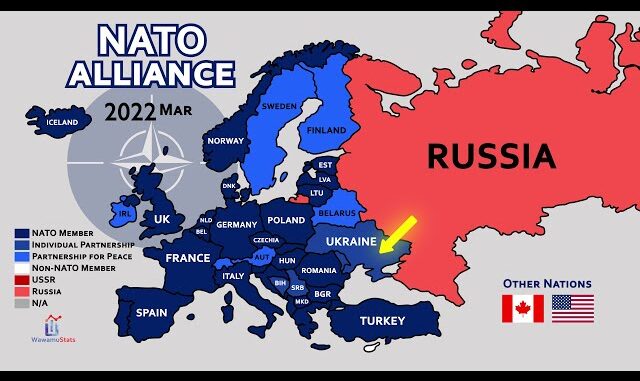
ENB Pub Note: This is the 4th article in a series from George, and much of this was covered in our first podcast. He is an international geopolitical and energy expert looking at energy from a global academic geopolitical perspective. Our first podcast was over 2 hours and felt like 5 minutes as it was tying a lot of questions that I was tracking. We are recording more episodes in greater detail on each of the areas. The other articles and podcast links are below.
George McMillan III, Follow on LinkedIn
The Energy Situation in Europe
The United States foreign policy planners have successfully separated their European allies from affordable energy sources by rapidly moving NATO Eastward encircling all of the oil and natural gas pipelines emanating from Russia.
As explained in the previous three articles in this series, the goal is to prevent Russia from infrastructurally integrating with Germany and following the PMESII/DIME SWOT analysis explained in the previous articles, ultimately aligning with Russia economically, diplomatically, and militarily.
The US foreign policy planners have successfully replaced affordable Russian oil and natural gas delivered by overland pipeline with Liquified Natural Gas shipped overseas that is roughly 30% more expensive and far less versatile—BASF needs natural gas for the Haber-Bosch process at its Ludwigshafen headquarters plant to make fertilizer for the world’s agricultural business.
Since energy costs are in every step of making every consumer good and service delivering them, the US has successfully driven up the costs of all goods and services yielding inflation, deindustrialization, job loss, and living standard decline in Europe in general and Germany especially.
The problem that the US policy planners face now is how to replace the cheap Russian oil and natural gas delivered by pipeline with something that is equally affordable before the next election cycle in the US and Europe, especially as the AfD gained popularity in the Thuringia and Saxony elections in early September of 2024.
If the Europeans simply elect politicians to repair the Nordstream pipelines and return to purchasing Russian oil and natural gas by paying directly in Rubles per US sanctions, then the last 30 years of the neoconservatives’ effort, along with the hundreds of thousands of dead and maimed Ukrainian soldiers, will have backfired tremendously.
The Purpose of NATO
The Purpose of NATO since World War Two has always been to keep the US in Europe, to keep Germany down in Europe, and to keep the USSR out of Europe. It appears that after the collapse of the USSR, the purpose of NATO has been extended to Russia, and the three-hundred-year-old Great Game of the Anglosphere to prevent a Haushofer integration of German Industrial power with Russian energy and immense resources continues.
If the Alternative for Deutschland party and Sahra Wagenknecht’s BSW party continue to gain support in Germany and repair the Nordstream pipelines to full capacity, then this policy path could completely reverse Kennan’s Five Industrial Power Center strategy and (a) put Russia in Europe, (b) unite the German World and Central Slavic World in Europe, and (c) push the US out of Europe. US diplomatic pressure has increased on the Visegrad leaders of Central Europe such as Aleksandar Vucic in Serbia, Robert Fico in Slovakia, and Victor Orban in Hungary to prevent such a domino effect in Central Europe.
The US foreign policy planners are acutely aware of this and are now desperately scrambling for solutions before the populist movements gain more support in the German and Slavic Worlds.
Echoing Professor Mearsheimer’s sentiment, the US tends to have the “reverse Midas touch” since the Vietnam War, a “reverse Midas touch” that has continued since the Global War on Terror (GWOT) and might carry through to the proxy war in Ukraine.
Since GWOT, US policy planners have a recent history of (1) destabilizing Iraq and essentially leaving Iran in charge of the Shia Arab-dominated country, (2) destabilizing Syria and strengthening the position of Shia Iranian-backed militia (IBM) Hezbollah in Southern Lebanon and Southern Syria, (3) destabilizing Libya with no solutions to restabilize it, (4) left $80 billion worth of weapons and training to the Sunni Pashtun Taliban during the withdrawal from Afghanistan, which (5) effectively returned the US from the regime-change nation-building agenda of GWOT to the regime-change destabilization strategies associated with Zbigniew Brzezinski Stansfield Turner’s Operation Cyclone of the late 1970s, with (5) the intent of disrupting as much Russian and Chinese infrastructure integration projects in Central and South Asia as possible.
The neoconservative war hawks in Washington and London have recently been encouraging Israel to attack Iran. The underlying significance is that invading Iran would offer a convenient means of rerouting the natural gas-rich Persian Gulf and Caspian Sea region pipelines away from China’s Silk Road network Westward to Armenia and Georgia instead.
The invasion of Iran would off a means of moving the oil and natural gas affordably through pipelines while also (a) avoiding all Russian territory (b) re-route as much energy Westward to deny it from China, (c) solving the European energy problem in a few years-time, and (d) undermine China’s Silk Road overland logistical supply route strategy to avoid the Anglosphere’s maritime chokepoint strategy. However, time is running short as the US election cycle is already underway with both Donald Trump ahead in the US polls and the AfD rising in Germany.
Geopolitical Significance
Two things are significant in Europe that are of concern for the US policy planners.
First is that the evils of increased energy costs, inflation, and deindustrialization will continue to rise in Western Europe and fuel mass protests in several Central European countries.
Secondly, LNG by ocean-going tanker is necessarily a sea power coping strategy in opposition to a land power advantage of oil and natural gas when these issues are placed in terms of post-Mahan and Mackinder ‘sea power and land power’ geopolitical strategies. There is simply no way LNG is a permanent solution for the German Industrial World and the rest of Central Europe in the longer term.
Sooner or later the Europeans will figure out that inflation is rising steadily and their fiat currencies are losing value as their countries are deindustrializing, while job losses mount and living standards fall, and Europe is placed in the fast lane on Hayek’s “road to serfdom.” The middle class can see that as their monthly heating, transportation, and grocery bills are all rising.
As discussed in Antony Blinken’s book Ally Against Ally, the US’s course of action has been to cut off its Western European allies from cheap Russian oil and natural gas by pipeline while providing them with alternative affordable energy sources to preserve its European alliances against the influence of cheap Russian energy.
The Eastward expansion of the EU and NATO Eastward to surround Russia and Belarus to cut off Germany and Central Europe from affordable energy supplies is likely to accelerate the US’ loss of allies instead. The effort to trap vassal state allies has the potential to create the conditions under which they no longer wish to be allies.
All that needs to happen is for the AfD and other popularist movements to gain more support in Germany and across Central Europe and for Donald Trump to win the US Presidential election in America and the US-European NATO alliance would essentially be finished. The combination of the neoconservatives, neoliberals, and Leftists that form the ruling coalitions in the West, are likely to pull out all stops and prevent the rise in popularist movements in North America and Europe to prevent this chain reaction from occurring.
The natural gas by pipeline domino chain reaction could go into effect if the Nordstream pipeline system were to be repaired and natural gas starts feeding the German automobile and petrochemical and agricultural industries again. An analysis of the various solution courses of action and political constraints will be discussed in the next article.
[end]
Part 3: The Geopolitical Problem of the US—a German-Russo-Japanese Connection
Part 2: Pipelines and Global Political Center of Gravity Alternatives: A PMESII DIME Analysis
Part 1: Part 1:Russian Natural Gas and Geopolitical Realignment—a reverse domino theory
ENB #160 What is the United States afraid of? George McMillan, CEO of McMillian Associates, stopped by the Energy News Beat podcast. – UPDATE
Follow Stuart On LinkedIn and Twitter





